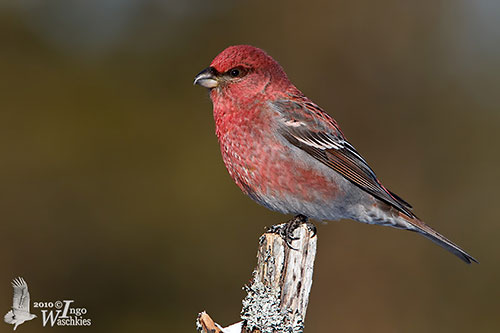
Fr: Durbec des sapins
Ang: Pine Grosbeak
All: Hakengimpel
Esp: Camachuelo Picogrueso
Ita: Ciuffolotto delle pinete
Nd: Haakbek
Sd: tallbit
Photographers:
John Anderson
John Anderson Photo Galleries
Ken Havard
My Bird Gallery & Flickr gallery 1 & Flickr gallery 2
Ingo Waschkies
Bird Photography
Text by Nicole Bouglouan
Sources:
HANDBOOK OF THE BIRDS OF THE WORLD Vol 15 by Josep del Hoyo-Andrew Elliot-David Christie - Lynx Edicions – ISBN: 9788496553682
FINCHES AND SPARROWS by Peter Clement, Alan Harris and John Davis – Helm Identification Guides – ISBN: 0713652039
All About Birds (Cornell Lab of Ornithology)
The Birds of North America online
Bird Web (Seattle Audubon Society)
What Bird-The ultimate Bird Guide (Mitchell Waite)
Audubon Flathead - Pine Grosbeak
The Boreal Avian Modelling Project
MORPHOLOGICAL VARIATION IN NORTH AMERICAN PINE GROSBEAKS
Pine Grosbeak
Pinicola enucleator
Passeriformes Order – Fringillidae Family
INTRODUCTION:
The Pine Grosbeak is a big boreal finch of the family Fringillidae. It frequents coniferous forests in Alaska, in W mountains of USA, in Canada, but also in the subarctic Fennoscandia and Siberia. It feeds primarily on small fruits, especially in winter, but seeds, buds, shoots and some invertebrates are also part of its diet. This species is monogamous and solitary nester. It is resident and partial migrant, and may exhibit irruptive behaviour while moving long distances for food.
The Pine Grosbeak is described as locally common or seasonally common throughout its usual range. It is not globally threatened.
DESCRIPTION OF THE BIRD:
Biometrics:
Length: 18-26 cm
Weight: 42-77 g
The Pine Grosbeaks of the New World are larger than the Old World races, and they have divergent DNA.
The adult male of nominate race has reddish-pink head and upperparts, but mantle and back are mainly grey with dark grey to blackish tips. Lower back and rump are bright pink, and uppertail-coverts are dark grey with pink edges. The tail is black with narrow pale pink edges. On the blackish upperwing, both median and greater converts show pinkish-white tips, forming two pale wingbars. The dark flight-feathers are edged whitish or pale pink, but with broader edges on tertial’s fringes.
The underparts are like the upperparts, or slightly paler due to the whitish bases of the feathers. The chin is whitish. Lower belly and undertail-coverts are greyish-white or tipped pink.

Adult male
P.e. enucleator
On the head, crown, nape and face are like the upperparts. The area from lores to beneath the eye is blackish. There is a greyish moustachial stripe and the lower part of the ear-coverts is greyish too.
The stout, hook-tipped bill is blackish, but the lower mandible has pinkish base. The eyes are very dark. Legs and feet are dark brown to blackish.
The adult female lacks the pink feathers of the male. She has mostly grey back and underparts, whereas head, breast and uppertail-coverts are olive-yellow to yellowish-green, or sometimes tinged darker orange. The wings are dark grey with two white wingbars. The tail is dark brown with pale olive-brown edges. On the head, the area from lores to beneath the eye is pale grey. Chin, throat and throat sides are grey.
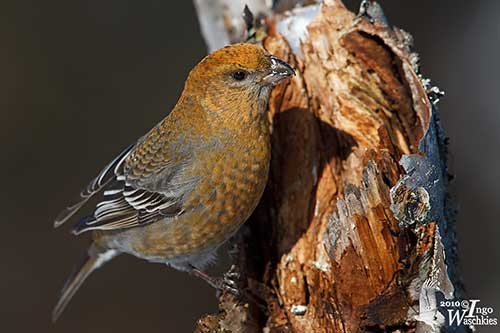
Adult female
P.e. enucleator
The juvenile resembles female but it is greyer. The head is tinged yellow. The rump is dull yellowish-brown. The upperwing-coverts show broad, pale buff edges. Ear-coverts, throat and breast are buffish.
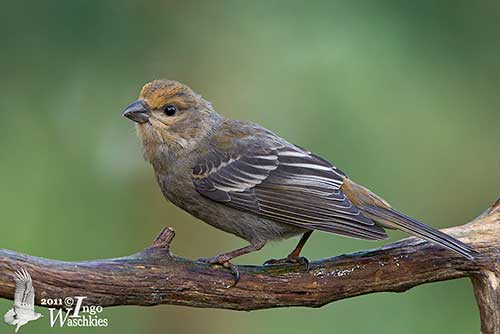
Juvenile
P.e. enucleator
SUBSPECIES AND RANGE:
The Pine Grosbeak has nine subspecies. The races differ mainly in size, length, depth and width of the bill, and in intensity of male plumage colours. The North American races are larger than nominate, but they have shorter bill and black sings and tail.
There are five North American races ranging from Alaska Peninsula through Canada, NE and WC USA to E California (Sierra Nevada). These races are P.e. flammula, P.e. leucura, P.e. carlottae, P.e. montana and P.e. californica.
The race P.e. leucura is named American Pine Grosbeak.
The four European races range from Scandinavia through Siberia to Sakhalin, Kuril Islands and N Japan (Hokkaido). These races include P.e. enucleator (named Eurasian Pine Grosbeak), P.e. pacata, P.e. kamtschatkensis and P.e. sakhalinensis.
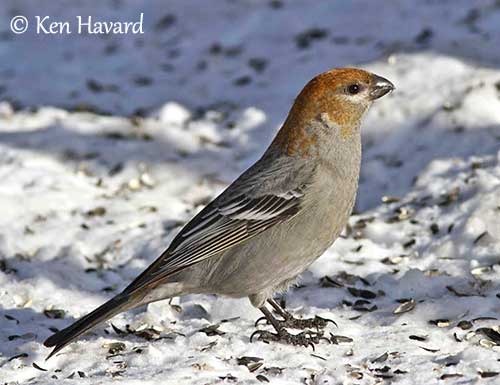
Adult female
P.e. montana
HABITAT:
The Pine Grosbeak breeds in coniferous forests with spruce, fir, larch and cedar. During winter, it frequents other types of forests such as coniferous, deciduous, mixed forests and all areas where it can find food, including cities and suburban areas.
This species can be seen between 1,250 and 2,000 metres of elevation in Europe, and from 1,800 to 3,100 metres in North America.
CALLS AND SONGS: SOUNDS BY XENO-CANTO
The Pine Grosbeak male sings loudly from perches neat treetops. The call is a whistled “tee-tee-tew” with higher middle note. This call is frequently given by both male and female during the flight, and is also used as contact call between them.
The song is a series of flute-like, varied, musical warbles “fillip-illy-dilly-didalidoo” fairly similar to the song of the Purple Finch. The female sings occasionally.
When both mates are feeding together, the male sings softly and these sounds are known as “whisper songs”.
In Europe, the song is fairly similar to the song of the Woodlark.
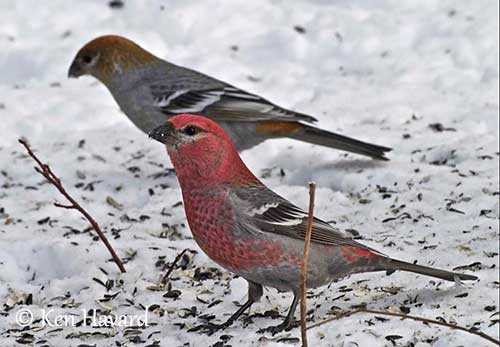
Pair
P.e. montana
BEHAVIOUR IN THE WILD:
The Pine Grosbeak feeds on seeds, buds, berries and insects. It feeds on plant matter mainly in winter, and takes seeds of conifers and other tree species, buds of maples and others, berries of numerous plant species, and occasionally seeds of weeds and grasses.
During winter, it also catches some insects including Orthoptera, Hemiptera, Diptera, Hymenoptera, Coleoptera and others. Spiders and snails are also taken.
It may visit feeders, especially for sunflower seeds.
It forages mainly up in trees and shrubs. It moves slowly in trees while eating buds, seeds and fruits. It may jump and perform clumsy flight to pursue aerial insects. It often joins small foraging flocks outside of breeding season.
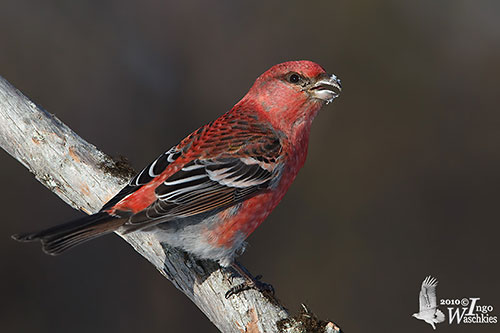
Adult male
P.e. enucleator
The Pine Grosbeak is monogamous and solitary nester. The pair forms when the birds arrive on the breeding grounds. The male defends the territory by singing from treetops.
Courtship feeding by male to female is part of the courtship displays. Other displays show the male circling the female in upright stance. Its plumage is sleeked while it raises the head and ruffles the breast feathers. The quivering wings are slightly drooped and the raised tail is partly fanned and flicked, while the bird sways its body from side to side. The female responds by a crouching posture prior to copulation. The nest is a bulky open cup built by the female.
The Pine Grosbeak is resident and partial migrant, and can be sometimes irruptive. The movements are closely related to food availability. When the food resources are limited, it may perform longer movements in late September-October, and it returns in late February to mid-March. It may performs small “invasions” southwards during winter, when food supplies fail in the far North.
The Pine Grosbeak performs shallow undulating flight, alternating several rapid wingbeats with wings drawn to sides.
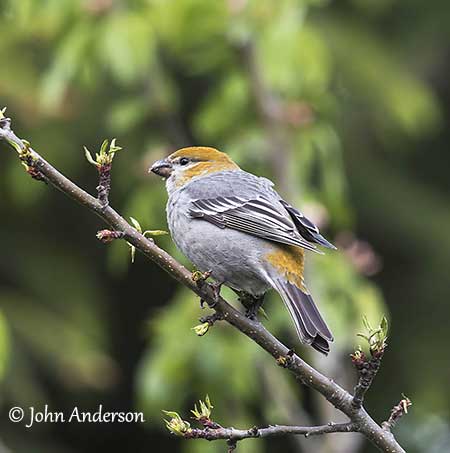
Adult female
P.e. leucura
REPRODUCTION OF THIS SPECIES:
The breeding season occurs between May and July. The female builds a bulky open cup placed on horizontal branch or in fork in conifer tree, often spruce or fir, about 2-6 metres above the ground, or lower in shrub.
The nest is made of twigs, rootlets and weeds, and the cup is lined with softer grass, lichens and moss. It is usually well hidden in the dense foliage.
The female lays 2-5, usually 4 bluish-green eggs with dark spots. The incubation lasts about 13-14 days by female alone, but she is often fed by the male during this period.
The chicks are fed by both parents that develop throat pouches, allowing them to carry more food at once. The young fledge 14-18 days after hatching, but they still depend on adults for food for 3 weeks after fledging.
This species produces only one brood per season.
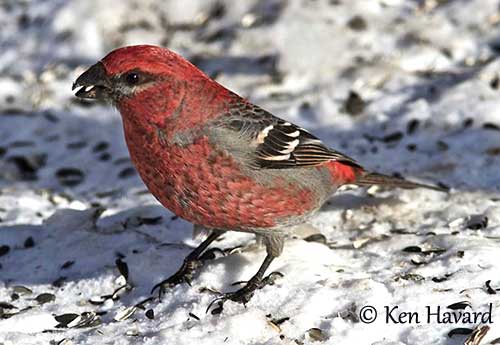
Adult male
P.e. montana
PROTECTION / THREATS / STATUS:
The Pine Grosbeak is described as widespread, or common to seasonally common throughout the range, although it is uncommon to rare in most of American range.
The global population is estimated to number more than 4,000,000 individuals (2004). The European population was estimated at 185,000/428,000 mature individuals in 2015.
Some decrease is observed in North America, but declines in C Finland during the latter part of 20th century may be due to heavy deforestation.
However, the species is not globally threatened and the Pine Grosbeak is currently evaluated as Least Concern.
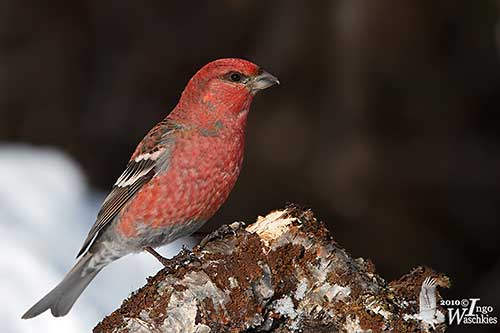
Adult male
P.e. enucleator